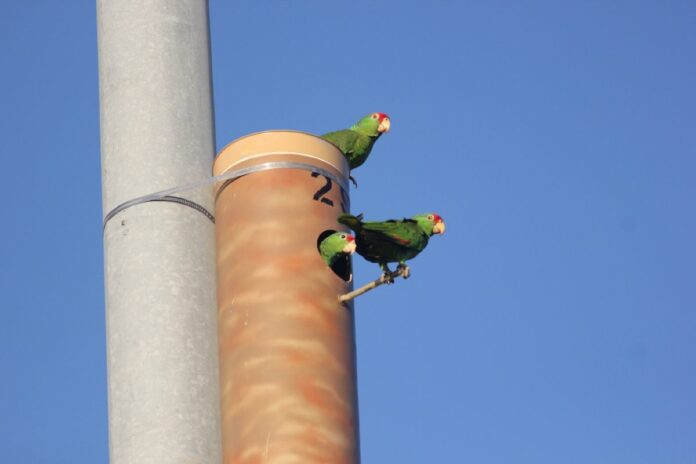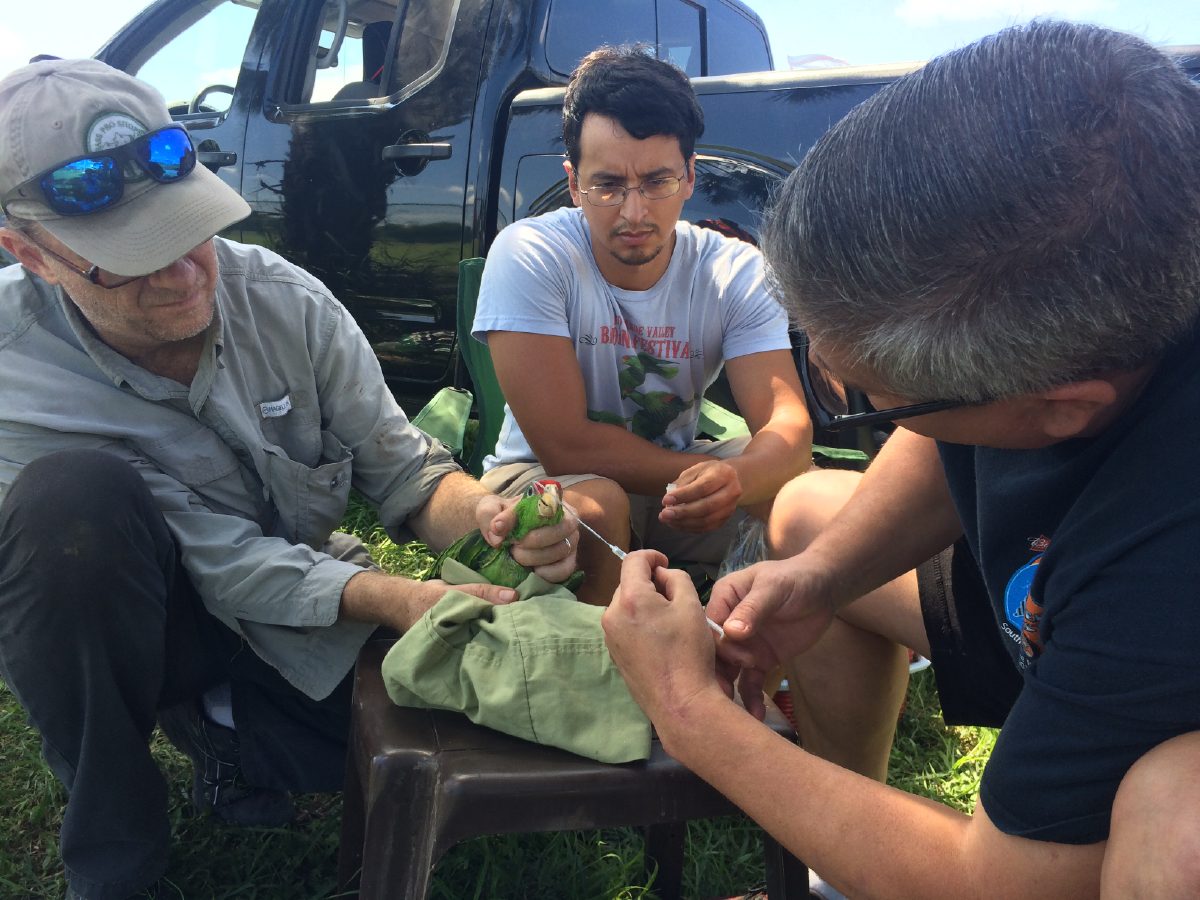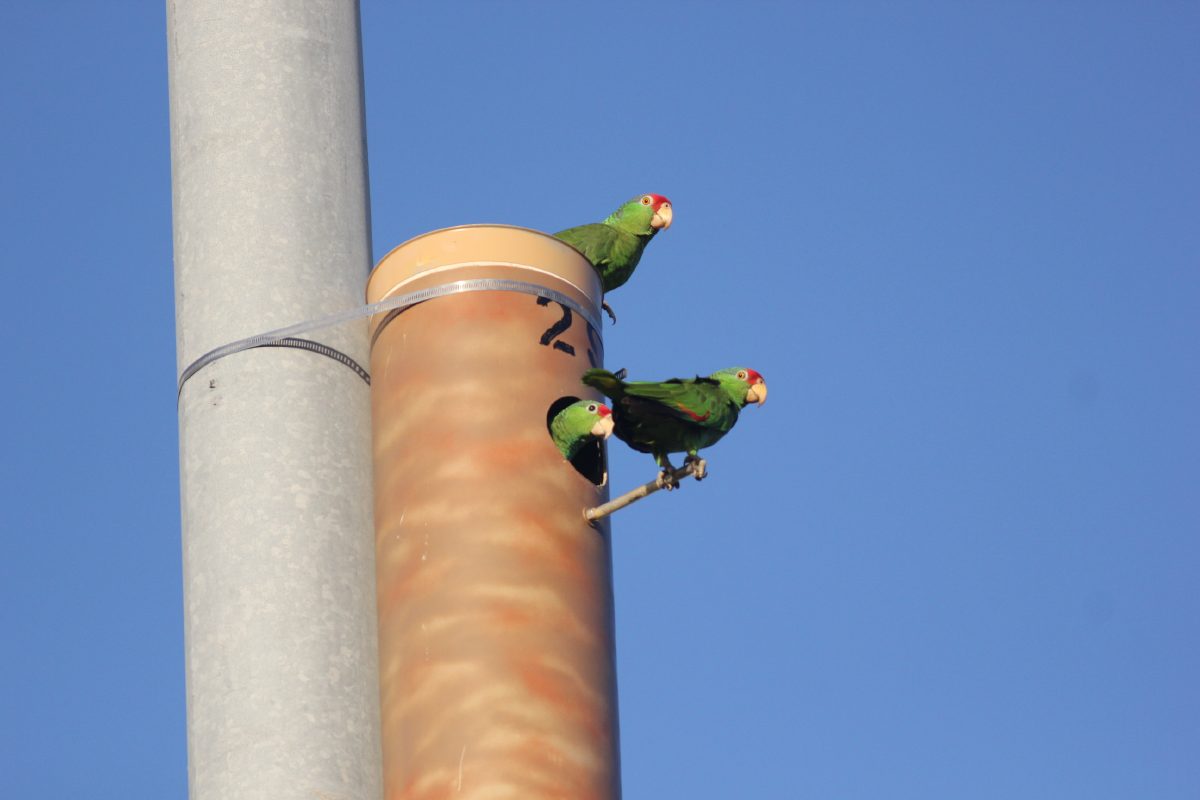Two nesting tubes erected in Lincoln Park last year were inhabited by red-crowned parrots much sooner than anticipated, and one of the structures even produced babies.
Two camouflaged PVC tubes were installed last March as Troop 6 Life Scout Zachary Edelstein’s Eagle Scout Service Project in partnership with the University of Texas Rio Grande Valley and Brownsville Public Utilities Board, which supplied a bucket truck and crew to install the structures high up on a light pole and a utility pole in the park.
Karl Berg, UTRGV assistant professor of ornithology and ecology, said his experience with nesting tubes in Brownsville over the past few years taught him that red-crowns are “pretty cautious and analytical” about the manmade nesting structures and don’t warm up to them quickly. He assumed it would take at least a year before any nested in the Lincoln Park “boxes,” but was thrilled to see several red-crowns inhabiting them last year, one pair producing two nestlings.
“I thought it might be a little disappointing, but they took to them almost immediately, and bred successfully within months of having them set up,” Berg said.
He thinks the parrots are getting used to seeing the tubes around Brownsville. About 40 have been erected in various places, about half with ladders and the rest with bucket trucks courtesy of BPUB and UTRGV. Red-crowns have been known to nest relatively close to the ground, though Brownsville’s parrots clearly prefer the tubes hung with bucket trucks, which are able to place them much higher on poles or palm trees, Berg said. The lower tubes have attracted whistling ducks, owls, woodpeckers and even grackles, but no parrots so far, he said.
Higher nesting tubes are also harder for wild predators to reach, though bucket trucks aren’t even enough apparently to protect them from human predators. The tubes are intentionally made deep to prevent people from reaching in and grabbing chicks, though Berg said someone — probably using a bucket truck — broke into a tube with a chainsaw on the UTRGV campus and stole two nestlings that were just about to fledge. Stealing or harming the birds, no matter how it’s done, is extremely illegal, he said.
“They’re very definitely being illegally trafficked, being illegally robbed from their nests and the nests destroyed,” Berg said. “It’s not young kids without a job, necessarily. It’s more at an industrial level, is what it appears to be to me.”
The tubes are meant to provide habitat for the parrots, which are endangered, as well opportunities to study them. The bird’s natural range is mostly limited to the Mexican state of Tamaulipas, with perhaps 700 inhabiting the Rio Grande Valley, Berg said.
In July, BPUB pitched in again to help capture the Lincoln Park nestlings so they could be weighed, measured, blood samples taken and ID rings attached before they fledged. BPUB took the tube down so it would be easier and safer to retrieve the young parrots, though even on the ground removing the lid was a bit of a chore, he said.
“Morris and Zach kind of did too good of a job putting the lids on,” Berg said. “We’d never really taken them off before, so it was a learning experience. We had to bang on the top a little bit, so (the nestlings) were pretty scared, but once we took them out they were actually very docile and really cute and didn’t know about all the bad things in the world yet. They were pretty nice to work with actually.”
Morris Edelstein is Zachary’s father and Troop 6 assistant scoutmaster. His son said assisting Berg with the project has been rewarding and that he thinks highly of the colorful, squawky creatures.
“I think it’s going pretty well,” Edelstein said. “The birds have been using them. … I’m really happy that I was able to work with Dr. Berg, and get those boxes up, and I got to watch it. It was really fun and I got to help out. It’s something I feel good about doing.”







